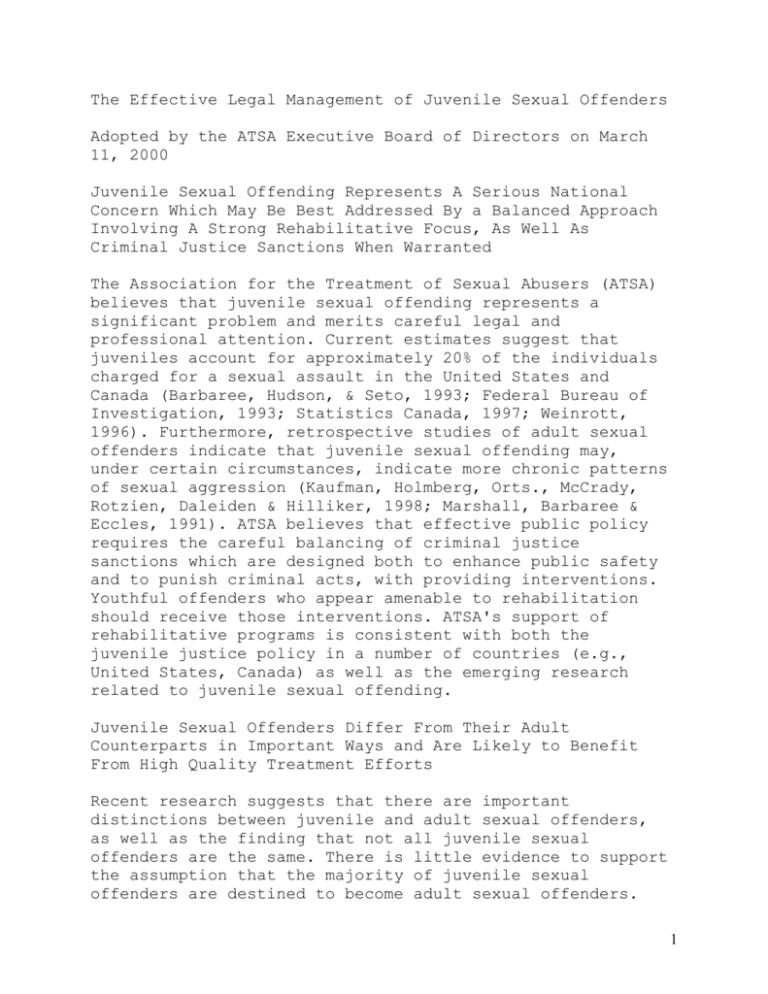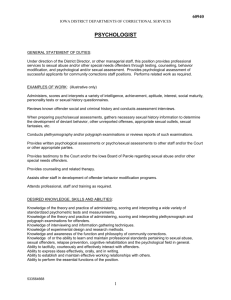The Effective Legal Management of Juvenile Sexual Offenders
advertisement

The Effective Legal Management of Juvenile Sexual Offenders Adopted by the ATSA Executive Board of Directors on March 11, 2000 Juvenile Sexual Offending Represents A Serious National Concern Which May Be Best Addressed By a Balanced Approach Involving A Strong Rehabilitative Focus, As Well As Criminal Justice Sanctions When Warranted The Association for the Treatment of Sexual Abusers (ATSA) believes that juvenile sexual offending represents a significant problem and merits careful legal and professional attention. Current estimates suggest that juveniles account for approximately 20% of the individuals charged for a sexual assault in the United States and Canada (Barbaree, Hudson, & Seto, 1993; Federal Bureau of Investigation, 1993; Statistics Canada, 1997; Weinrott, 1996). Furthermore, retrospective studies of adult sexual offenders indicate that juvenile sexual offending may, under certain circumstances, indicate more chronic patterns of sexual aggression (Kaufman, Holmberg, Orts., McCrady, Rotzien, Daleiden & Hilliker, 1998; Marshall, Barbaree & Eccles, 1991). ATSA believes that effective public policy requires the careful balancing of criminal justice sanctions which are designed both to enhance public safety and to punish criminal acts, with providing interventions. Youthful offenders who appear amenable to rehabilitation should receive those interventions. ATSA's support of rehabilitative programs is consistent with both the juvenile justice policy in a number of countries (e.g., United States, Canada) as well as the emerging research related to juvenile sexual offending. Juvenile Sexual Offenders Differ From Their Adult Counterparts in Important Ways and Are Likely to Benefit From High Quality Treatment Efforts Recent research suggests that there are important distinctions between juvenile and adult sexual offenders, as well as the finding that not all juvenile sexual offenders are the same. There is little evidence to support the assumption that the majority of juvenile sexual offenders are destined to become adult sexual offenders. 1 Moreover, the significantly lower frequency of more extreme forms of sexual aggression, fantasy, and compulsivity among juveniles than among adults suggests that many juveniles have sexual behavior problems that may be more amenable to intervention. In fact, recent prospective and clinical outcome studies suggest that many juveniles who sexually abuse will cease this behavior by the time they reach adulthood, especially if they are provided with specialized treatment and supervision. Research also indicates that juvenile offenders may be more responsive to treatment than their adult counterparts due to their emerging development. Juvenile treatment efforts may benefit as well, from the involvement of parents, caregivers, and family members, who are rarely participants in adult offender treatment. These studies, in addition to clinical observation, support the growing optimism that many juvenile sexual offenders can be successfully treated. Recommendations: 1. The Association for the Treatment of Sexual Abusers suggests that high quality, juvenile specific, community based treatment be mandated for juvenile sexual offenders whenever possible. ATSA questions the appropriateness of imposing adult sentences for the majority of the juvenile sexual offenders. Incarcerating juveniles in adult correctional settings may restrict their access to treatment, expose them to the potentially detrimental influences of antisocial adult role models, as well as create management and safety issues. ATSA believes that most juvenile sexual offenders can be safely and effectively managed in the community if they receive specialized treatment and court supervision. Such treatment should be based upon a comprehensive assessment that allows for the tailoring and titration of interventions based upon the risks presented by the juvenile offender. It is important to recognize that community-based treatment also offers opportunities for family involvement in the treatment process as well as reintegration into productive community roles (e.g., student, employee, family member). We also recognize that 2 some juveniles require treatment in a structured, secure residential program due to the severity of their psychosexual and psychiatric problems. ATSA recommends that sanctions which best serve the long-term interests of the community and the juvenile be considered and that those who make the final decisions have access to a broad range of potential sanctions and placement options. 2. The Association for the Treatment of Sexual Abusers believes that juveniles should be subject to community notification procedures in only the most extreme cases and instead that enhanced community monitoring and supervision should be provided to ensure public safety. ATSA believes that juveniles should be subject to community notification procedures in only the most extreme cases. The wide variation in how communities interpret and implement notification laws is problematic, especially with juvenile sexual offenders. In some states notification is restricted to the immediate area in which the adolescent resides, ignoring their ability to move beyond these limited geographic boundaries. In other areas, the implementation of community notification varies from jurisdiction to jurisdiction with some more restrictive in their commitment to implementing notification than others. Despite the questionable public safety benefits of community notification with juveniles, it is likely to stigmatize the adolescent, fostering peer rejection, isolation, increased anger, and consequences for the juvenile’s family members. Until research has demonstrated the protective efficacy of notification with juveniles and explored the impact of notification on the youth, their families and the community, notification--if imposed at all for juveniles-should be done conscientiously, cautiously, and selectively. 3. The Association for the Treatment of Sexual Abusers encourages the prosecution and adjudication of adolescent sexual offenders in the juvenile courts. At the same time, ATSA supports and encourages continued adherence to the Juvenile Justice system’s long standing commitment to a rehabilitative focus with juvenile sexual offenders. 3 We believe that juveniles should be held legally accountable for their behavior. Such accountability is necessary to assist the offender in taking responsibility for their offending behavior, to ensure compliance with therapeutic requirements, and to address the needs of the victim. As part of the adjudication process, it is recommended that juvenile sex offenders be evaluated by clinicians with specialized training in working with this population. Such evaluations should determine if the juvenile is amenable to treatment and to assist the court in identifying the most appropriate type and level of care. Treatment should be a court ordered requirement for each juvenile offender and should also be provided by clinicians who have specialized training and experience with this population. Evidence suggests that the vast majority of juvenile sexual offenders respond well to treatment and do not recidivate. Most juvenile sexual offenders can be safely and effectively treated in the community, if they are provided with specialized treatment and on-going court supervision. 4. The Association for the Treatment of Sexual Abusers supports the development of primary* (i.e., community focused) and secondary* (i.e., focused toward "at-risk" juveniles) prevention efforts as a potentially effective means of reducing risk factors that may foster the development of sexual offending in juveniles. Recent research suggests the potential for identifying risk factors related to child sexual abuse and the promise of utilizing such information to enhance the efficacy of national and community based prevention initiatives. Efforts to conceptualize child sexual abuse as a community health problem and to apply the Public Health Model (McMahon & Puett, 1999) to its prevention represent critical steps toward more effective prevention initiatives. ATSA will continue to advocate for increased prevention funding for intervention as well as research in this area. 5. The Association for the Treatment of Sexual Abusers encourages continued research on the etiology, assessment, prevention and treatment of juvenile sexual offending. 4 We particularly support research efforts directed at creating a juvenile sex offender typology and linking offender classification with risk assessment. Such research will contribute to an improved understanding of effective prevention and management strategies for addressing juveniles who engage in sexual aggression and provide needed guidance in determining the most appropriate clinical and legal dispositions for individual offenders. References Barbaree, H., Hudson, S., & Seto, M. (1993). Sexual assault in society: The role of the juvenile offender. In H.E. Barbaree, W.L. Marshall, & S.M. Hudson (Eds.), The juvenile sex offender (pp.1-24). New York: Guilford. Federal Bureau of Investigation. (1993). Uniform crime reports for the United States. Washington, DC: U.S. Department of Justice. Kaufman, K., Holmberg, J., Orts, K., McCrady, F., Rotzien, A., Daleiden, E., & Hilliker, D. (1998). Factors influencing sexual offenders’ modus operandi: An examination of victim-offender relatedness and age. Child Maltreatment, 3, 349-361. Marshall, W., Barbaree, H., & Eccles, A. (1991). Early onset and deviant sexuality in child molesters. Journal of Interpersonal Violence, 6, 323-336. McMahon, P. & Puett, R. (1999) Child sexual abuse as a public health issue: Recommendations of an expert panel. Sexual Abuse: A Journal of Research and Treatment, 11, 257266. Statistics Canada. (1997). Canadian Crime Statistics, 1996. Ottawa, Ontario, Canada: Statistics Canada, Canadian Centre for Justice Statistics. Weinrott, M.R. (1996). Juvenile sexual aggression: A critical review. Boulder, CO: Center for the Study and Prevention of Violence. 5




